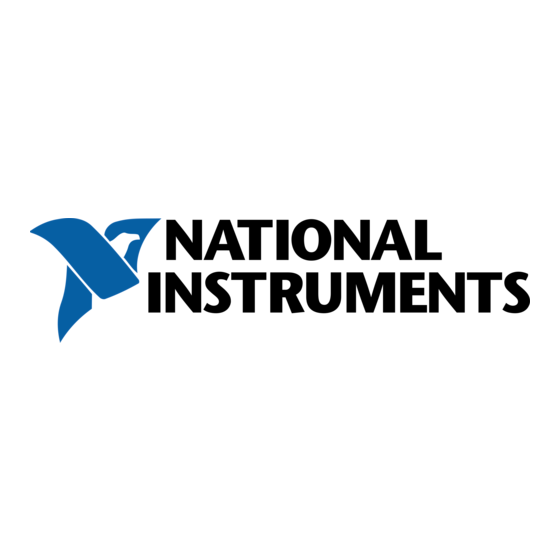
Table of Contents
Advertisement
Quick Links
VXI-TB-1303 32-C
T
ERMINAL
Introduction
®
®
LabVIEW
, NI-DAQ
, and CVI ™ are trademarks of National Instruments Corporation. Product and company names are trademarks or trade
names of their respective companies.
321567A-01
HANNEL
B
LOCK
This guide describes how to install and use the VXI-TB-1303 terminal
block with a VXI-SC submodule.
The VXI-TB-1303 terminal block is a shielded board with screw
terminals that connect to a VXI-SC submodule. The VXI-TB-1303 has
a high-accuracy thermistor cold-junction temperature sensor, and an
isothermal copper plane to minimize the temperature gradients across
the screw terminals when you measure with thermocouples.
The terminal block has 80 screw terminals for easy connection.
Thirty-two pairs of screw terminals connect to the 32 differential inputs
of the VXI-SC submodule. Four terminals labeled GND connect to the
submodule's chassis ground pins. The AIREF, AOREF, GUARD,
OUTPUT, OUT0+, OUT0-, OUT1+, OUT1-, OUT2+, OUT2-, OUT3+,
and OUT3- terminals are reserved for use with future VXI-SC
submodules.
The VXI-TB-1303 terminal block has a pull-up resistor connected
between CH+ and +5 V and a ground-reference resistor connected
between CH- and chassis ground. This pull-up resistor helps you detect
open thermocouples by detecting saturation of the VXI-SC submodule
amplifier output. The ground-reference resistor references floating
thermocouples to ground.
© Copyright 1997 National Instruments Corp. All rights reserved.
I
SOTHERMAL
April 1997
Advertisement
Table of Contents

Summary of Contents for National Instruments VXI-TB-1303
- Page 1 ® ® LabVIEW , NI-DAQ , and CVI ™ are trademarks of National Instruments Corporation. Product and company names are trademarks or trade names of their respective companies. 321567A-01 © Copyright 1997 National Instruments Corp. All rights reserved. April 1997...
-
Page 2: What You Need To Get Started
What You Need to Get Started To set up and use your VXI-TB-1303, you will need the following: VXI-TB-1303 terminal block VXI-TB-1303 32-Channel Isothermal Terminal Block Installation Guide One package of four 10 Ω resistor networks VXI-TB-1000 terminal board carrier and documentation... - Page 3 Product Name Pin 1 of RP2 (see note below) Serial Number Figure 1. VXI-TB-1303 Parts Locator Diagram Note: Notice that pin 1 is in the same location on each resistor network socket, and is represented by a square, in Figure 1.
- Page 4 Temperature Sensor and Switch Configuration To enable you to use thermocouples with VXI-SC submodules, the VXI-TB-1303 terminal block has a thermistor temperature sensor for cold-junction compensation. You can connect the temperature sensor to a VXI-SC submodule in either of two ways: •...
-
Page 5: Configuring The Resistor Networks
The 10 MΩ ground-reference networks are recommended for use with the VXI-SC-1102 and are factory installed. The VXI-TB-1303 terminal block has a pull-up resistor connected between CH+ and +5 V and has a ground-reference resistor connected between CH- and chassis ground. Figure 2 shows how the pull-up and ground-reference resistors are connected to the CH±... -
Page 6: Changing Resistor Networks
Connecting an external ground-referenced signal with the 10 Ω Ω Ω Ω ground- Warning: reference resistor network in place may cause permanent damage to the resistor network and the traces on the VXI-TB-1303 printed circuit board. National Instruments is liable for any damage or injuries resulting from improper signal connections. -
Page 7: Open-Thermocouple Detection
10 MΩ Resistor Network Figure 3. Resistor Networks Open-Thermocouple Detection The VXI-TB-1303 circuitry helps you detect an open thermocouple. To detect whether any thermocouple is open, check whether the corresponding VXI-SC submodule channel is saturated. The VXI-TB-1303 has pull-up and ground-reference resistors that saturate the channel by applying +5 V at the input of the open channel. - Page 8 However, if your application demands extremely high accuracy, you can eliminate this offset error by calibrating your system. You can also remove the pull-up resistor network, giving up the open-thermocouple detection feature in the process, or use the 10 Ω ground-reference resistor networks, which will bring the common-mode voltage down to nearly 0 VDC.
- Page 9 If your thermocouple is grounded on the negative lead, as shown in Figure 5, or grounded on the positive lead, as shown in Figure 6, a leakage current of approximately 0.5 µA (5 V/10 MΩ) will flow through your thermocouple. The resultant measurement error will be 4.4 µV for the example thermocouple, based on the equation: 1 lead x 8.78 Ω...
-
Page 10: Temperature Sensor Output And Accuracy
Temperature Sensor Output and Accuracy The VXI-TB-1303 temperature sensor voltage output varies from 1.91 to 0.58 V over the temperature range, as shown in Table 4. Table 4. Temperature Sensor Voltage Output Accuracy... -
Page 11: Temperature Sensor Circuit Diagram
The VXI-SC-1102 has a 2 Hz filter on the V signal. TEMPOUT Temperature Sensor Circuit Diagram The circuit diagram in Figure 7 provides optional details about the VXI-TB-1303 temperature sensor. +5 V 4.7 kΩ 2.5 V 5 kΩ LM 4040 0.1%... -
Page 12: Specifications
Specifications Cold-junction sensor Accuracy ........0.65° C from 15° to 35° C 1.0° C from 0° to 15° and 35° to 55° C Repeatability ........0.35° C from 15° to 35° C Output..........1.91 (at 0° C) to 0.58 V (at 55° C) Open thermocouple detection Pull-up resistor ........10 MΩ...













Need help?
Do you have a question about the VXI-TB-1303 and is the answer not in the manual?
Questions and answers